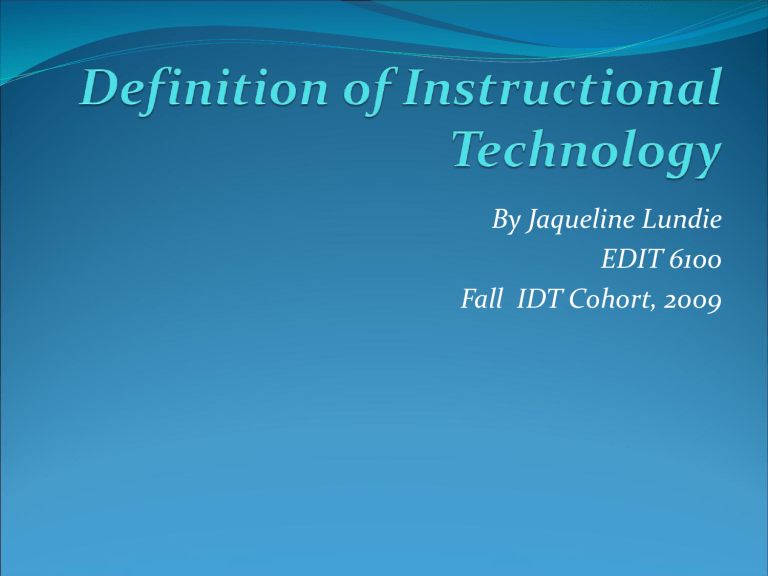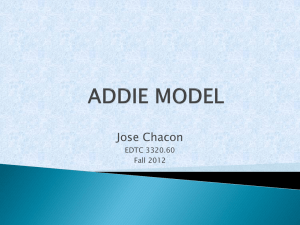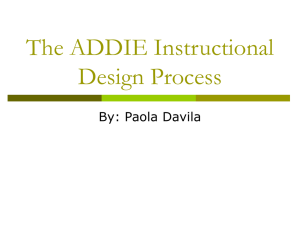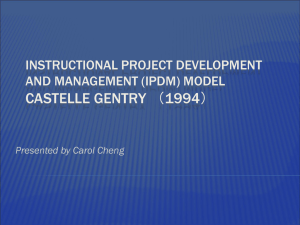Definition of Instructional Technology

By Jaqueline Lundie
EDIT 6100
Fall IDT Cohort, 2009
Instructional Technology is a systematic process used to design, manage, and evaluate various ways of presenting various subject matter in order to enhance teaching and learning. It is the process of creating a learning system that caters to an individuals learning style by using technological resources. It is the process of using technological tools to meet learning objectives.
Design
The Five Domains of Instructional
Technology
Development
Utilization
Theory Practice
Management
Evaluation
Descriptions For Each
Domain
Design refers to the process of specifying conditions for learning.
Development refers to the process of translating the design specifications into physical form.
Utilization refers to the use of processes and resources for learning.
Management refers to processes for controlling instructional technology.
Evaluation is the process for determining the adequacy of instruction.
Early Definitions
In early definitions instructional technology was viewed as media.
1960s and 1970s instructional technology was viewed as a process.
AECT 2006 definition of instructional technology is as follows: Educational technology is the study and the ethical practice of facilitating learning and improving performance by creating , using, and managing appropriate technological processes and resources.
ADDIE Instructional Design
Model
ADDIE MAP The ADDIE instructional design model provides a step-by-step process that helps training specialists plan and create training programs. The ADDIE design model revolves around the following five components:
Analysis
Design
Development
Implement
Evaluate
The ADDIE Model
Analysis – in this phase you simply think through what you want to do.
Design - you create a blueprint for your course on paper.
Develop – develop any remaining content and begin to build the course.
Implement - in this phase you begin instruction.
Evaluate – in this phase you will evaluate your course design by looking how well your audience achieved the stated learning outcomes.
The Proper Way to Become an
Instructional Technologists
Here are a list of things one needs to do to become and remain an instructional technologists.
Work with people and take a genuine interest in their interest and listen.
Study the design process, study how people learn individually and collectively, and study media's role in learning.
Strive to understand the interdependency of theory, research, and practice.
Learn
Play the "how's and what's" of media.
What are the Roots of
Instructional Technologists?
The field is essentially a 20th century movement with the major developments occurring during and immediately after World War II. What began with an emphasis on audiovisual communications media gradually became focused on the systematic development of teaching and learning procedures which were based in behavioral psychology. Currently, major contributing fields are cognitive psychology, social psychology, psychometrics, perception psychology, and management. The basic history of the field was written by Saettler.
What do Instructional
Technologists Do?
Most instructional technologists carry out one or a few of the functions performed in the field. For example, some design instruction, some produce instructional materials, and others manage instructional computing services or learning resources collections.
Major Professional Organizations
Here is a list of some the professional organizations in the field of instructional technology.
American Educational Research Association (AERA)
American Society for Training & Development (ASTD)
Association for Educational Communications & Technology
(AECT)
International Society for Performance Improvement (ISPI)
Association for Learning Technology (ALT)
Dick and Carey's model is one of the many models used by instructional technology designers.
Fundamental Components of
Instructional Design
These components are interrelated and could conceivably make up an entire instructional design plan.
Nine Elements of a Comprehensive
Instructional Design Plan
Evaluation
Instrument
Instructional
Problems Learner
Characteristics
Instructional
Delivery
Designing the Message
Task Analysis
Instructional
Objectives
Instructional
Strategies
Content
Sequencing
References
Reiser, R.A. (2002) What Field Did You Say You Were In? Defining and naming our field.
In Reiser, R.A. & Dempsey, J.V. (Eds.). Trends and issues in instructional design and technology. Upper Saddle River, NJ: Merrill/Prentice Hall
ADDIE Model (2009). Retrieved September 9, 2009 from http://www.learningtheories.com/addie-model.html
Instructional Design using the ADDIE Model (2009), Retrieved September 10, 2009 from http://raleighway.com/addie/index.htm
Rieber, L (1998). The proper way to become an instructional technologist. Retrieved
September 9, 2009 from http://it.coe.uga.edu/~lrieber/pdean/
The Field of Educational Technology: Update 2000. A Dozen Frequently Asked
Questions from http://www.ericdigests.org/2000-4/2000.htm
Lee, H, & Lee S (nd). Dick and Carey . Retrieved September 9, 2009 from http://www.umich.edu/~ed626/Dick_Carey/dc.html
Introduction to the Instructional Design Process , Retrieved November 3, 2009 from https://www.elc.uga.edu/webct/urw/lc5122011.tp0/cobaltMainFrame.dowebct







